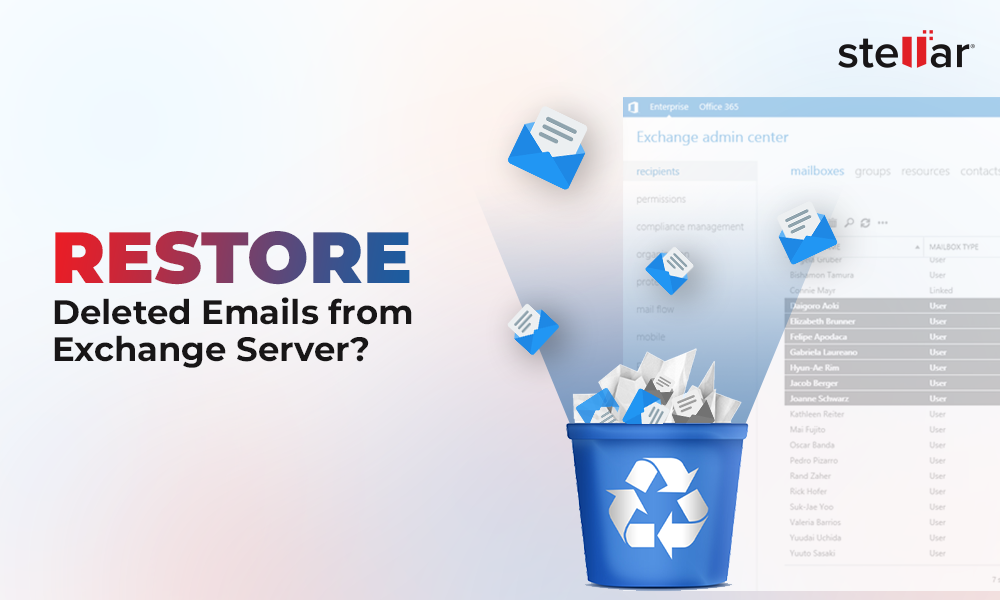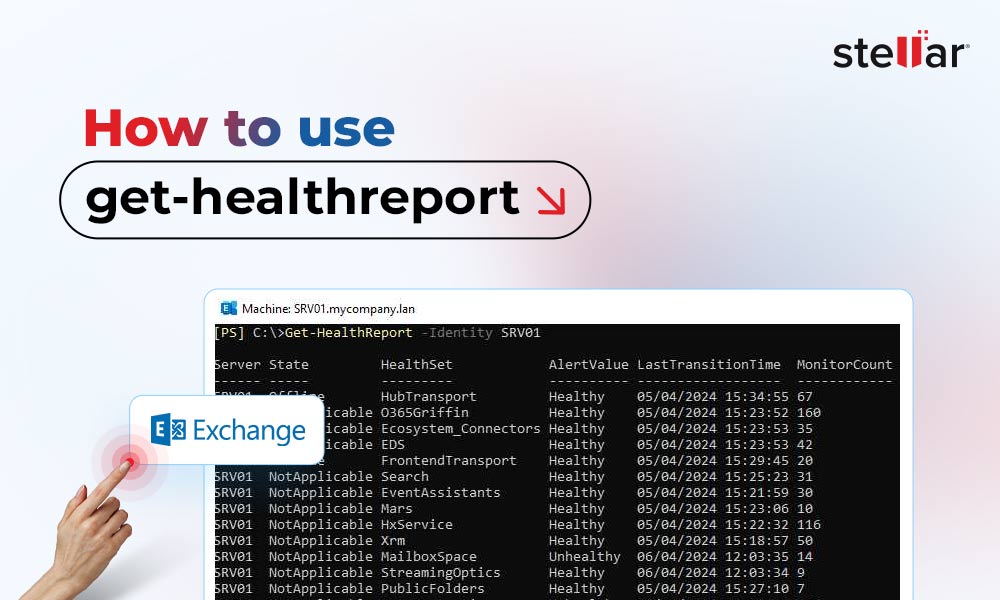MS Exchange is a powerful and reliable business-class email solution for organizations. One can set up either Exchange on-premises or online, based on business requirements. Although organizations are moving towards cloud-based email solutions, such as Exchange Online, Exchange on-premises is still widely used by many businesses across the globe.
In On-premises Exchange, the hardware ownership is in your hands. All the data, such as emails, contacts, attachments, tasks, notes, etc., is stored on a central server. Thus, it’s the responsibility of Exchange administrators to perform various Exchange management and backup tasks to ensure smooth performance and avoid data loss.
However, there are scenarios where the Exchange database may get damaged or corrupt due to inconsistency within the log and database files caused by server crash, power outage, viruses, etc. That’s where you can use the backups to restore the mailboxes and database on the server. But if the backup isn’t available or turns out obsolete or corrupt, the only solution is to use an Exchange recovery toolkit, such as Stellar Toolkit for Exchange.
What is Stellar Toolkit for Exchange & Why It is an Ideal Solution for Microsoft Exchange Administrators?
Administrators don't mind the work, but their time is precious. So, they need the best tools to do the job fast and do it right. Stellar Toolkit for Exchange is one such tool. You may call it Swiss army knife for any Exchange administrator. It is a combination of powerful and specialized Exchange recovery tools that enables Exchange admins to repair, recover, and restore corrupt or damaged Exchange databases, mailboxes, lost Windows server password, and convert EDB or OST to PST format. It also helps extract and restore the mailbox database (EDB), STM, and log files from Exchange backups (.BKF).
Exchange admins can use this toolkit to deal with all kinds of problems and issues related to the Exchange server and ensure consistent performance and email flow. Following are a few prominent features of the Toolkit:
- Repairs and recovers offline, inaccessible, dismounted, or corrupt Exchange database
- Extracts mailboxes from offline or online (hosted) EDB & saves them to PSTs
- Extracts mailboxes from corrupt or damaged Exchange BKF or VHDX file
- Migrates mailboxes from a decommissioned Exchange server database
- Recovers lost or deleted mailboxes from EDB
- Converts inaccessible, orphaned or damaged OST to PST
- Resets and recovers Windows Server 2012, 2008, 2003, & 2000 passwords
- Exports recovered mailboxes and OST to MSG, EML, HTML, & RTF formats
- Exports contacts directly to CSV
- Supports Exchange 2019, 2016, 2013, 2010, 2007, 2003, 2000, and 5.5

Repair and Recover EDB Files
You cannot restore the mailboxes from a decommissioned server and attach them to an Exchange server or export the mailbox data or folder, if the Active Directory from the decommissioned or old server is removed. In such cases, you would need a copy of the Active Directory and have to restore the whole Exchange server to export the mailbox, which will take a considerable amount of time and administrative effort for just recovering one folder or mailbox.
Stellar Toolkit for Exchange can help you scan and repair an inaccessible, corrupt, or damaged EDB file, extract mailboxes and save them as PST or export them to a live Exchange server directly. The software comes in handy when you need to recover and migrate mailboxes from a decommissioned server to different Exchange, Office 365, or any other cloud platform. All this can be done in a few clicks with minimal efforts.
Restore Deleted Mailboxes
You might find yourself in a sticky situation where a mailbox was accidentally deleted. A department in your organization may have requested for removing some unused mailboxes and then later, after a day or two, asking to restore them.
However, after being deleted, there is no way to recover the mailboxes, apart from restoring the EDB file along with its logs. Although this can be done by using the ESEUTIL and creating a recovery database, but this requires you to perform multiple steps, such as:
- You need to restart the Information Store service, which will disrupt user's access
- Mount the recovery database
- Verify that the database contains the mailbox you want to recover
- Then use the PowerShell cmdlet New-MailboxRestoreRequest to recover the mailbox
- Once this process is done and the mailbox is restored, you would need to do a clean-up of the procedure
Also, this works only if you have a backup of the database readily available. Plus, this process will take a lot of time and effort. But most importantly, it will disrupt communication in the organization as users are going to experience downtime on the Exchange server due to the Information Store service restart.
Of course, the admins are most likely to avoid this process and rather prefer a tool, such as Stellar Toolkit for Exchange, to restore the accidentally deleted or lost mailboxes and mailbox items. The software highlights the deleted mailboxes with red color to help you recover and restore deleted mailboxes and mailbox items quickly. Again, you can either save the recovered mailboxes to PST file or export to the Exchange server. This job can be done efficiently depending on the size of the mailbox, without the complications of manual mailbox restoration process.
BKF Recovery Tool
If you have taken backups of old Exchange server by using NTBackup in BKF format, you will not be able to restore the EDB file from it without having a Windows Server 2003 to use the NTBackup application.
Also, imagine a scenario where the last backup of this old Windows/Exchange server 2003 was interrupted for a reason and at the time of restore, you cannot open the BKF file to recover the EDB file or mailboxes. This may happen due to backup corruption. That’s why it’s suggested to always test the backups to ensure that they will work when a disaster strikes.
The corruption may happen due to a hardware malfunction or malware. For this situation, Stellar Toolkit for Exchange brings a BKF Recovery tool that can extract the EDB, STM, and log files from a corrupt or inaccessible BKF backup file on the Exchange server. After recovery, you can save the extracted files and data at the same location or a defined one.
Convert OST files to PST
OST is the local cache of an Exchange mailbox, which is created by the Outlook for offline use. But why would you need to convert an OST to PST?
There are various scenarios and reasons where you may need to convert OST file to PST. For instance,
- If a mailbox or user account gets deleted from the server, the OST becomes orphaned and turns inaccessible. Unlike PST, an OST is encrypted by default and requires authentication for access. In such cases, you need to recover the mailbox items stored in the OST as the mailbox is no more available in the EDB. This can happen, for example, when a user left the company and the organization requests to have his mailbox backed up or restored for investigation purposes or if the person rejoins later.
- Another reason would be due to corruption of the Outlook application. In such a case, you may need to delete the OST file and let Outlook rebuild the OST file from scratch. The only problem is that the new OST file will only have data that was uploaded or synced to the Exchange mailbox.
- In a major Exchange Server crisis where the user needs to access his emails urgently but cannot wait until the issue has been rectified, converting OST data to PST may help. With the OST to PST converter, the user can easily view and convert the OST file to PST without any effort. Once the conversion is done, the user can import or open the PST to access unsaved data in a new profile. You can also drag the missing items from the imported PST to the live mailbox.
Exchange Password Recovery
There could be several scenarios where Exchange admins may forget or lose the password. For instance,
- Imagine a situation where the organization’s only IT administrator, who is taking care of all the IT systems, asked to leave the company. And before leaving, the person changes all the admin passwords, while no one else notices or knows the passwords?
- Another case would be that the local IT admin changes the admin password for security reasons but either forgot the password as the admin might get overwhelmed with work and forgot to document it or the keyboard was in a different language and didn't notice that some characters were misplaced during the change.
- When one needs to boot up an old server with its Active Directory and the password was not documented. Of course, one can always reset the password from the Active Directory server, but what if the Enterprise Admin has also been changed and there is no other user with the same access level?
In all such cases and scenarios, with the Stellar password recovery tool, you will be able to reset any Windows Server password and regain access to your vital servers. In case only the Enterprise Admin password has been changed, the tool can also reset the password of any server acting as Domain Controller.
To Sum up
Stellar Toolkit for Exchange is an ideal tool for any organization, having its on-premises Exchange server administrated by one or two people. It will surely minimize downtimes and assist in various restore tasks, as anyone can use the software. Further, it is compatible with all Microsoft Exchange servers, including the new Exchange server 2019. You can install it on any computer being Windows 7 or higher, or Windows Server from 2003 till 2012.
This 5-in-1 Exchange Recovery Toolkit is the best assistant for any Exchange admin.















 4 min read
4 min read





